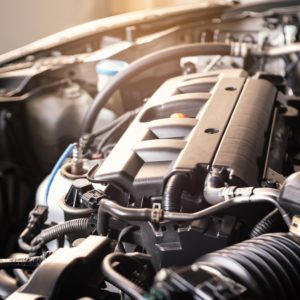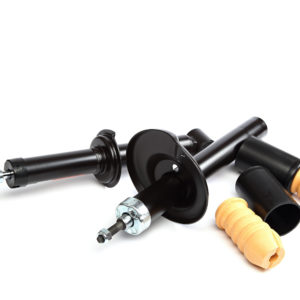Automakers are always testing new technologies to improve a driver’s control over their vehicle. First, there was the anti-lock braking system (ABS), which prevents skidding and keeps the wheels from locking up. Next was traction control, which stops wheels from spinning uselessly if their tires fail to get a good grip on the ground’s surface.
Now, there is electronic stability control (ESC). This automatic computer-driven system lets drivers retain control by improving stability to keep the vehicle traveling in the right direction.

What is Electronic Stability Control?
ESC is a computer-driven system that helps stabilize the vehicle on the road. It incorporates the vehicle’s ABS and traction control systems and relies on a plethora of sensors that observe the vehicle’s current level of traction.
Other names for the ESC include “electronic stability program” (ESP) and “dynamic stability control” (DSC).
Electronic stability control first debuted in 1995 when Mercedes-Benz introduced the Electronic Stability Program on its Mercedes-Benz S 600 Coupé. Other major car manufacturers eventually developed their own ESC systems.
Electronic stability control operates on any type of ground surface.

What are the Parts of Electronic Stability Control?
Depending on its design, an electronic stability control system may include the following parts:
- Electronic control unit (ECU)
- Steering wheel angle sensor
- Yaw rate sensor
- Accelerometer or lateral acceleration sensor
- Wheel speed sensor
- Longitudinal acceleration sensor
- Roll rate sensor
- Hydraulic modulator

Some electronic stability control systems feature an override switch that turns off the system when it isn’t needed. Other systems can switch to a mode with higher thresholds so that the ESC won’t immediately react at the slightest sign of oversteering.
How Does Electronic Stability Control Work?
Electronic stability control constantly keeps track of the wheels’ traction through various sensors:
- Steering sensor – observes how the driver steers the vehicle with the steering wheel
- Yaw sensor – looks out for sudden shifts in the vehicle’s momentum
- G-force sensor – observes changes in the vehicle’s cornering forces
When it notices the vehicle deviating from the directional path the driver is traveling on, electronic stability control goes into action.
To give you an idea of how it works, let’s take oversteering as an example. The front wheels spin at different speeds, with the outer wheel spinning faster than the inner one. The speed difference can cause the car to spin out of control.
Electronic stability control prevents oversteering by applying the brake on the outer front wheel. By slowing down the faster-spinning wheel, the speed difference between the front wheels is reduced.
Some ESC models may also briefly reduce the engine’s power output. These electronic stability control systems can back off the throttle, delay the ignition spark timing, or do both. The drop in engine power slows the vehicle down, making it easier to handle.


What Does Electronic Stability Control Do for Your Vehicle?
Electronic stability control helps the driver retain control of their vehicle even when it’s skidding or sliding. It lowers the risk of crashes caused by uncontrollable vehicles, reduces the severity of any crash that does take place, and can prevent injuries or even save lives.
ESC can also prevent an SUV or a vehicle with a similarly high center of gravity from rolling over. It has become a standard feature on such vehicles.
Contrary to what some may think, electronic stability control doesn’t enhance the vehicle’s ability to corner. Instead, it will increase the driver’s control over the vehicle while taking a corner.
While electronic stability control activates much faster than the average human driver, it isn’t infallible. If the vehicle is going too fast, it may exceed the corrective ability of ESC, which acts as the vehicle’s handling and traction.
Are There Drawbacks to Electronic Stability Control?
Skilled drivers who operate high-performance vehicles may find electronic stability control more of a hindrance. ESC may intervene in situations where the way the driver steers the vehicle doesn’t reflect the direction he wants to go.
For example, the motorsport driving technique called drifting has the driver deliberately oversteering the vehicle while cornering. While the wheels lose their grip on the road, the driver remains in full control.
Unfortunately for professional drifters, electronic stability control cannot distinguish between controlled drifting and accidental oversteering. It will compensate for the deliberate oversteering, which can lead to the very accident ESC was designed to prevent.
To accommodate these drivers, some vehicles have override controls that partially or fully disengage the electronic stability control.

Is Electronic Stability Control Effective?
Many agencies have investigated the effectiveness of electronic stability control. Their studies showed that ESC performed very well in its intended role.
The National Highway and Traffic Safety Administration (NHTSA) examined the effectiveness of electronic stability control in the US. Their field study showed the following:
- ESC reduces vehicle crashes by 35%
- SUVs with electronic stability control avoid 67% more accidents than non-ESC-equipped SUVs
Likewise, a 2006 study by the United States Insurance Institute for Highway Safety (IIHS) found the following:
- Equipping all US vehicles with electronic stability control could prevent up to 10,000 fatal crashes every year
- ESC made fatal crashes 43% less likely to happen
- It reduced the chances of fatal single-vehicle crashes by 56%
- It lowered the risk of fatal single-vehicle rollovers by 77–80%
Signs of a Malfunctioning Electronic Stability Control
Some signs of a malfunctioning ESC include an illuminated warning light, poor traction, brake issues, noise and vibration, and loss of control.
Illuminated Warning Light
An illuminated ESC warning light when driving in normal conditions indicates the system is malfunctioning. The ESC light icon is a car with two squiggly lines, but it could vary depending on your car’s model.
Poor Traction
Since the ESC system helps maintain control, any issues within the system can result in noticeable handling problems. Some common ones include reduced traction or stability on slippery surfaces.
Brake Issues
The ESC also works closely with the anti-lock braking system (ABS), so a malfunctioning ESC may result in unusual braking behavior, like slow or unresponsive braking.
Noise and Vibration
You may also notice strange noises and vibrations while driving. There are a handful of possible reasons why these manifest, but they might be due to faulty ESC sensors.
Loss of Control
In extreme cases, you may feel a loss of control over your vehicle during sharp turns or maneuvers.
Does Your Car Have Electronic Stability Control?
When electronic stability control first came out in 1995, it wasn’t available as a standalone feature. Instead, it was usually found in a vehicle’s high-end trim and came with other features. ESC was also not available as an aftermarket option.
In 2009, the NHTSA established Federal Motor Vehicle Safety Standard (FMVSS) No. 126. This regulation required the presence of electronic stability control on all passenger cars and light trucks.
Starting in 2012, all vehicles introduced that weighed 10,000 pounds (5,000 kilograms) or less have electronic stability control as standard equipment.
Check the owner’s manual or other trustworthy resources to verify the presence of electronic stability control in any vehicle built before 2012. An ESC will increase the car’s price tag, but it will more than pay for its cost by preventing rollovers and other accidents.

Getting Replacement ESC Parts for Your Vehicle
If you think driving around with faulty ESC parts is safe, think again. A malfunctioning electronic stability control system may cause your vehicle to skid. In other words, you’re at greater risk of getting into an accident the longer you drive with a non-functional ESC. For your own safety, you should avoid driving until you fix your ESC system’s defective parts. Luckily, getting replacement ESC parts is fast and easy with CarParts.com.
CarParts.com offers a wide selection of steering angle sensors, yaw rate sensors, and other ESC parts, all sourced from the most trusted manufacturers in the industry. Easily browse through our catalog with the help of our vehicle selector and search filters. Just be sure to put your vehicle’s correct details so you can view all the available parts that are compatible with it. If you’re itching to get back on the road, you’ll be pleased to know that CarParts.com also guarantees fast shipping. Order by 12 p.m. ET, and you can get your new ESC parts in as fast as two business days.
Don’t wait until your electronic stability control system completely fails before replacing defective parts. Check out our selection of high-quality steering angle sensors, yaw rate sensors, longitudinal acceleration sensors, and more at CarParts.com today!
Any information provided on this Website is for informational purposes only and is not intended to replace consultation with a professional mechanic. The accuracy and timeliness of the information may change from the time of publication.































